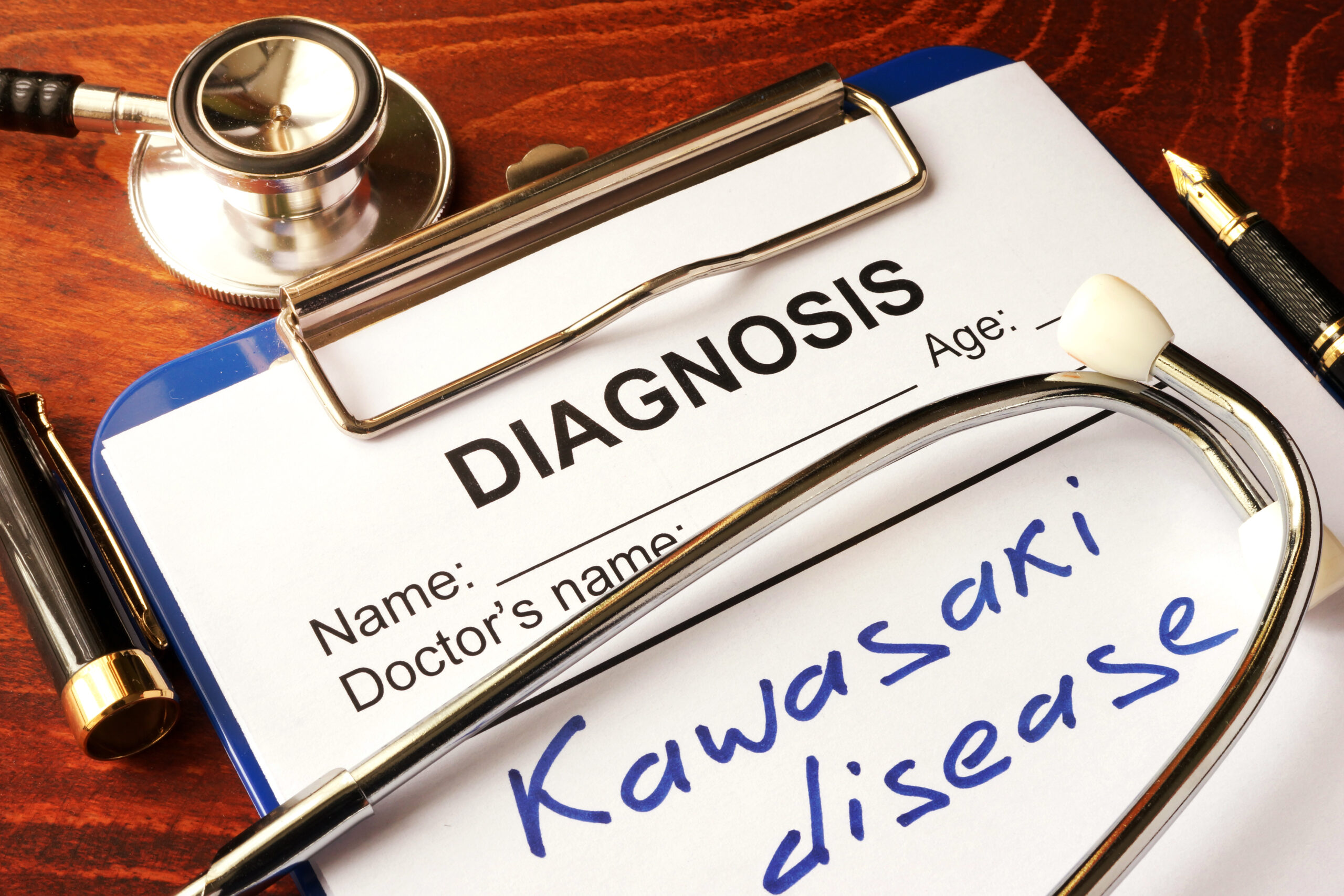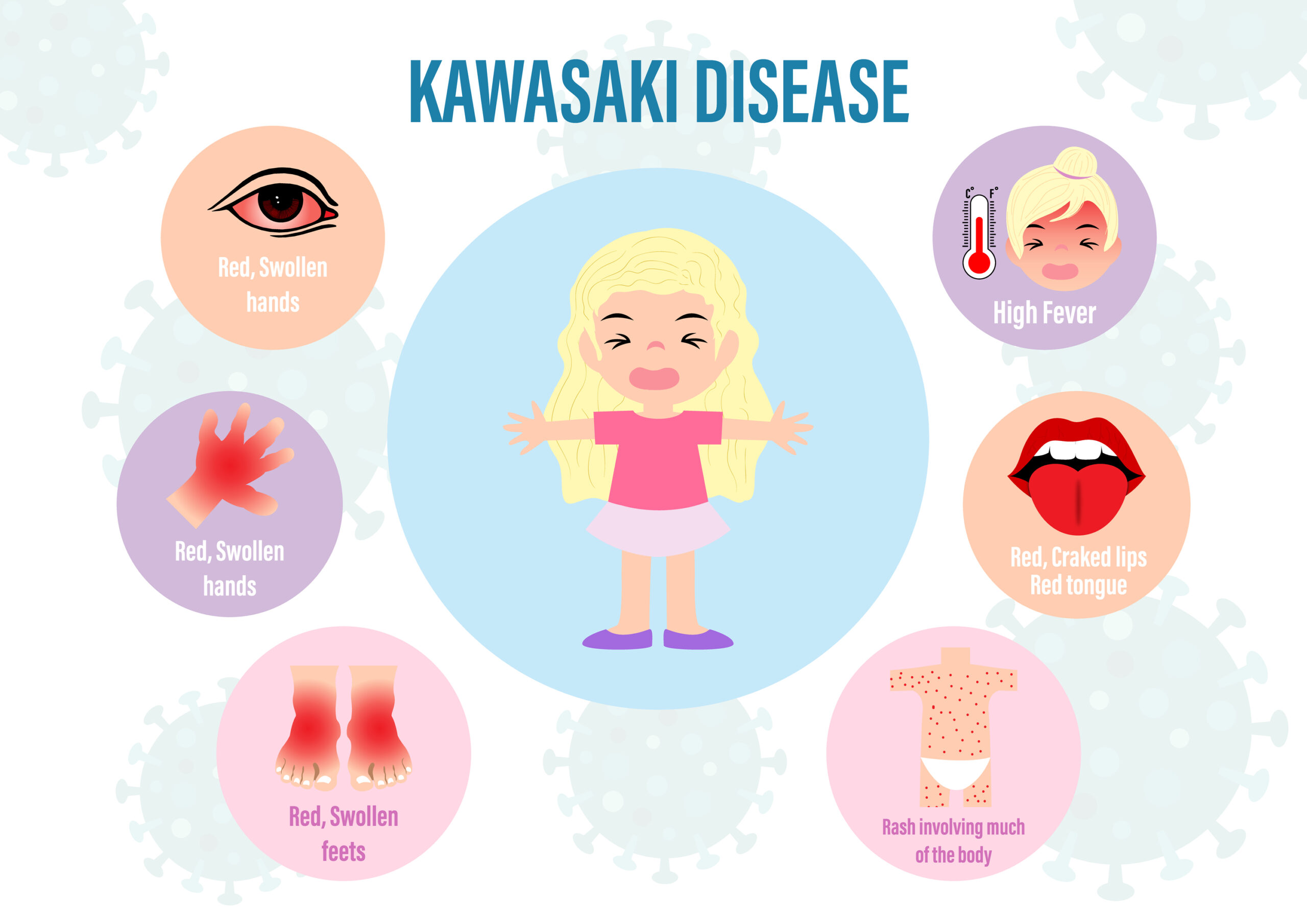Kawasaki Disease is a febrile disease involving an acute inflammation of the arteries. When arteries become inflamed, they can weaken and stretch out. This puts them at risk of tearing or narrowing, limiting blood flow to nourish tissues and organs.
Kawasaki disease is a condition that predominantly affects children below the age of five. Fortunately, this illness typically resolves within 12 days without any lasting complications. While most children fully recover, there are instances where severe cardiac complications may arise, so it is essential to provide prompt treatment to prevent severe cardiovascular issues. Notably, Kawasaki disease was first identified by Tomisaku Kawasaki in Japan in 1967. In developed countries, it is the leading cause of acquired heart disease among children.

Kawasaki disease can be observed globally, although its prevalence varies greatly depending on the geographical location and ethnic community. The highest incidence occurs in children of Asian origin (75-85% of cases), especially in Japanese.
In the United States, the CDC estimates that the incidence of the disease is 9 to 20 per 100,000 children under five years of age.
Kawasaki disease mainly affects children aged six months to five years. The peak incidence occurs at the age of 12-18 months. In infants, the course of the disease may be atypical, which makes it more challenging to recognize and usually more severe than in older children. The disease affects boys slightly more often. Kawasaki disease in adults and children over 13 years of age occurs very rarely.
The causes of the disease are still unknown. It is assumed that in genetically predisposed people, there is an abnormal response of the immune system to antigens of infectious agents (e.g., bacteria or viruses, but also to environmental factors).
This causes infiltration of the blood vessel walls by inflammatory immune system cells, which may destroy the vessel walls. The disease process may affect any tissue or organ. Often, the patient is diagnosed with a recent upper respiratory tract infection before symptoms appear.
Kawasaki disease is not contagious because bacteria, viruses, or parasites do not cause it. Although the symptoms of the disease may resemble those of infectious diseases, it certainly cannot infect others.
Three known factors increase the risk of developing Kawasaki disease:
Kawasaki disease can be divided into several phases:

The acute phase lasts 1 to 2 weeks![]() . The main symptoms include:
. The main symptoms include:
Inflammatory changes can affect various organs, causing symptoms of:
The subacute phase of the disease begins after the fever and other symptoms subside. Lasts approximately 2-4 weeks![]() .
.
Your child may still experience symptoms such as:
The recovery phase lasts approximately two weeks. During this time, the child's well-being improves, inflammatory markers normalize, and symptoms disappear.
Patients with Kawasaki disease require long-term observation, heart tests, and assessment for the risk of developing atherosclerosis (lipid panel control).
It may be necessary to perform imaging tests to exclude disease complications. The risk of recurrence is estimated at approximately 2%![]() , often with a similar course.
, often with a similar course.
The basis for diagnosing the disease is its characteristic symptoms. According to The National Institute for Health and Care Excellence (NICE)![]() , a child may be suspected of having the disease if they have a fever lasting at least five days and one additional symptom from the list:
, a child may be suspected of having the disease if they have a fever lasting at least five days and one additional symptom from the list:
In infants, the picture of the disease may be different, without a large part of the main symptoms, compared to older children. Some symptoms might come and go through the illness duration, so it is necessary to tell the doctor if your child has experienced a sign that is not present anymore.
Symptoms of Kawasaki disease may resemble other diseases such as scarlet fever, measles, Stevens-Johnson syndrome, toxic shock syndrome, lupus, viral meningitis, and glandular fever. Therefore, doctors may need to rule them out to confirm the diagnosis.
Some tests may help confirm the diagnosis. These include:
During the acute phase of the disease, several heart symptoms may appear, such as tachycardia (when the heart beats too fast), heart inflammation (myocarditis), fluid accumulation around the heart, or coronary artery aneurysm. Also, because the most common complications of the disease involve the heart, children who have had Kawasaki disease must undergo tests to check whether the heart is functioning correctly. These tests include:
The conditions whose symptoms are similar to Kawasaki Disease and hence might be mistaken for it include:
A multisystem inflammatory syndrome similar to Kawasaki disease has been observed in children infected with SARS-Cov-2. However, there are significant differences between these two diseases. The disorders usually occur in children of different ages. Severe gastrointestinal symptoms appear in the case of COVID-19, and there are also differences in laboratory parameters – in SARS-CoV-2, there is thrombocytopenia (low number of platelets) and a reduced number of white blood cells in blood.
Scarlet fever is caused by a bacteria – group A Strep. Mainly, children are affected, although the disease occurs sporadically in adults. The source of the condition is the sick person.
Scarlet fever has symptoms similar to Kawasaki disease. The disease begins abruptly. Fever usually appears first and can reach up to 40 degrees Celsius. Chills and severe sore throat accompany it. Other symptoms of scarlet fever that resemble Kawasaki disease include:
However, the diseases differ in etiology – in scarlet fever, the cause of the disease is a bacterium. In contrast, the cause of Kawasaki disease is not fully known. Also, some symptoms allow the doctors to distinguish the two conditions from each other (lesions in the hands and feet in Kawasaki disease, characteristic lack of rash around the mouth in scarlet fever).
Measles and Kawasaki disease have many shared features![]() , such as high fever, rash, conjunctivitis, and enlarged lymph nodes. However, in the case of measles, the fever usually subsides after a few days, and there is no skin peeling on the hands and feet.
, such as high fever, rash, conjunctivitis, and enlarged lymph nodes. However, in the case of measles, the fever usually subsides after a few days, and there is no skin peeling on the hands and feet.
The condition needs to be treated in the hospital because it poses a risk of serious complications. Treating Kawasaki disease quickly after its onset can significantly reduce the risk of complications – changes in arteries, as well as other severe cardiac complications that are the leading cause of death.
Treatment mainly involves:

Aspirin (acetylsalicylic acid) is prescribed to children with Kawasaki disease. This is a rare occasion when this medication is used in children under 16 years as using it may cause a dangerous complication – Reye's syndrome. For this reason, you should never give your child aspirin unless the doctor specifically recommends it.
Aspirin lowers fever, reduces pain and discomfort, reduces swelling and inflammation (in large doses), and prevents the formation of clots through its antiplatelet effect (in small amounts).
In Kawasaki disease, aspirin protects the vessels supplying blood to the heart against clot formation.
IVIG, short for Intravenous Immunoglobulins, is a therapy that involves injecting antibodies obtained from healthy individuals directly into a vein. These antibodies, known as immunoglobulins, are proteins produced by the immune system to combat harmful microorganisms like bacteria and viruses. Specifically, the treatment utilizes a subtype of immunoglobulins called gamma globulins.
In Kawasaki disease, immunoglobulins reduce fever and the risk of heart complications. After administration of immunoglobulins, the child's condition should improve within 36 hours.![]()
The most severe complications of the disease are changes in the cardiovascular system, such as:
Each of the complications can damage the child’s heart. Inflammation of the coronary arteries can weaken and bulge the artery wall, causing aneurysm. Aneurysms can raise the chances of developing blood clots, which in turn can result in a heart attack or dangerous internal bleeding.
About 25%![]() of children with Kawasaki disease develop complications if left untreated. Children under the age of one are more susceptible to experiencing severe complications.
of children with Kawasaki disease develop complications if left untreated. Children under the age of one are more susceptible to experiencing severe complications.
In a small percentage of children with coronary artery problems, Kawasaki disease can cause death, even with treatment.
Kawasaki disease is the main reason for acquired heart disease in kids. However, with effective treatment, only a few children have permanent heart damage.
Since the disease has no known cause, it cannot be prevented. Bacteria, viruses, or parasites do not cause Kawasaki disease, so there is no way to avoid getting it.
You should consult a pediatrician if you notice symptoms that may indicate Kawasaki disease in your child, such as prolonged fever accompanied by skin lesions, conjunctivitis, or strawberry tongue.
Kawasaki disease is a rare illness that can be difficult to diagnose because its symptoms, such as fever, sore throat, and rash, are not specific and can also occur in more common conditions like the common cold or pharyngitis. However, if these symptoms are severe, last for a long time, or if the child's condition worsens, it is important to seek immediate medical advice.